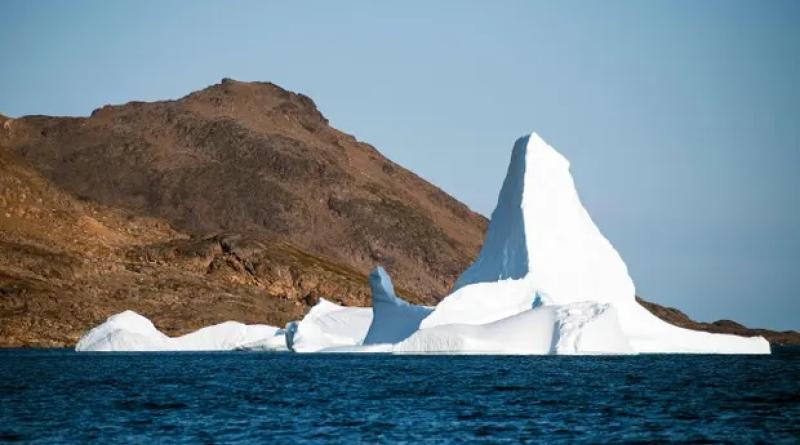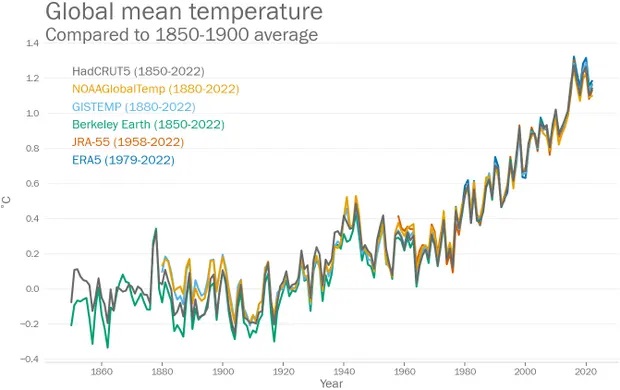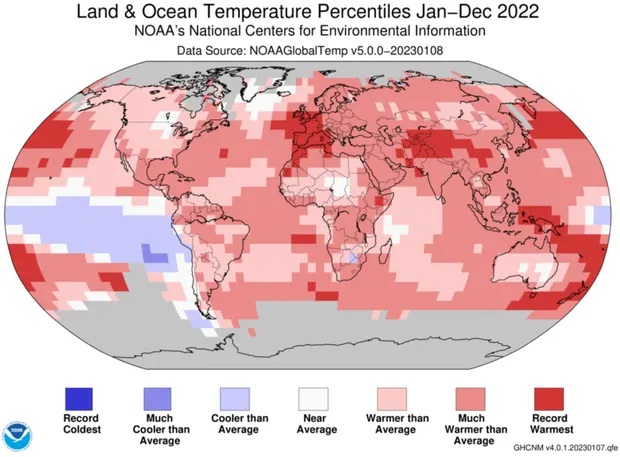Warm 2022 makes the past eight years hottest ever recorded

World Meteorological Organization data shows last year’s average temperature was 1.15C more than pre-industrial levels
The relentless challenge of global heating has again been underscored by the tally of a passing year, with 2022 ranking as one of the warmest years ever recorded and the past eight years now collectively the hottest documented by modern science.
Last year’s average temperature was about 1.15C warmer globally than levels seen in the pre-industrial era, according to the World Meteorological Organization (WMO), with searing, record heat enveloping much of Europe and Asia, which both experienced their second hottest years on record. Europe had its warmest ever summer.
The cooling influence of La Niña, a periodic climate event now in its third year that delivers brisker temperatures to parts of the globe, helped take some of the edge off the 2022 heat, with the year ranking as either the fifth or sixth hottest year on record.

WMO draws from six different datasets, including that of Nasa, which placed last year as the fifth hottest in the 143-year record, and the US National Oceanic and Atmospheric Administration (Noaa), which places the year as sixth, due to minor differences in data collection.
The long-term trend is starkly apparent, however, with the eight hottest years ever recorded all occurring since 2015, with 2016 still the hottest of them all, and each decade since the 1980s progressively hotter than the last. The 10 hottest years have all taken place since 2010.
Bill Nelson, Nasa’s administrator, said the warming trend was “pretty alarming, and it’s a trend that’s growing in magnitude.
“If we don’t take this seriously there will be deadly effects across the globe. Extreme weather patterns threaten our wellbeing across the planet and we need some bold action.”
This coming year threatens more of the same, with the WMO pointing out that La Niña conditions will probably wane after March, removing the ameliorating cooling effect from the heating caused by humanity’s ongoing burning of fossil fuels.
The rising heat augurs the sort of climate-induced disasters that punctuated 2022, including flooding that inundated approximately a third of Pakistan, a record heatwave that scorched China and wildfires that burned across Europe and north America. Heat and accompanying drought helped uncover sunken battleships and bombs in parched European rivers and human bodies in stricken US reservoirs.
“In 2022, we faced several dramatic weather disasters which claimed far too many lives and livelihoods and undermined health, food, energy and water security and infrastructure,” said Petteri Taalas, secretary general of the WMO, who added that a prolonged drought in the Horn of Africa “threatens a humanitarian catastrophe”.
The opening stanza of 2023 has already seen extraordinary heat bake much of Europe, while California has been repeatedly deluged by the sort of flooding that scientists warn is being worsened by the climate crisis.
The assessment of the latest year of elevated heat – 2022 was the 46th consecutive year with temperatures above the 20th-century average – includes millions of atmospheric and marine temperature recordings, as well as a health check on Earth’s other vital signs.

The average annual sea ice extent in the Arctic was the 11th smallest in a record stretching back to 1979, with the 10 lowest Arctic sea ice extents all happening since 2007, while the annual sea ice extent around Antarctica was the second lowest, surpassed only by the 1987 record.
Most of the heat trapped by the expulsion of greenhouse gases is going straight into the oceans, which had a record year for heat in 2022, a recent study found. The steep upward advance of ocean temperatures is a clearer, and better, indicator of the climate crisis than atmospheric temperatures that can be swayed by year-to-year variables such as the La Niña effect, according to Michael Mann, a climate scientist at the University of Pennsylvania.
“Some years ago we showed that we expect the streak of record-breakers to persist as long as we continue to warm the planet, but with these sorts of temporary interruptions due to natural variability,” he said. “So what we’re seeing here is what we expect.”
Rachel Licker, climate scientist at the Union of Concerned Scientists, said the rising temperatures should spur policymakers in the US and globally to do far more to cut planet-heating emissions.
“Instead of caving to fossil fuel industry interests aimed at growing their profits, we need strong leaders willing to implement bold climate policies for the betterment of people and the planet,” she said.
“Policymakers reluctant to move beyond incrementalism and companies engaging in greenwashing are quite frankly stealing the future that rightfully belongs to our children. The science is clear: large-scale, transformative action is the only path forward.”
COVER PHOTO: The average annual sea ice extent in the Arctic was the 11th smallest on record. Photograph: Jonathan Nackstrand/AFP/Getty Images





